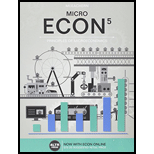
The meaning of market structure and the factors determining it.
Explanation of Solution
The term market structure refers to a system in which all the firms and customers in the market deals with each other and engage in some economic activities. All the firms sell their products in the market on a particular price. The products can be homogenous or heterogeneous in nature. The consumers buy these goods from the sellers in the market.
The factors which determine the market structure of a particular industry are as follows:
(a) Number of firms in the industry- In some market, the number of firms can be very large and in some market it can be very limited or in some market there is only one firm operating in the market.
(b) Number of buyers in the industry- Just like the number of firms in the industry can vary; the number of buyers can also vary. In some markets the numbers of buyers are huge and in some markets the buyers are as low as only one buyer.
(c) Type of products- There can be different types of products in the market; they can be homogenous or heterogeneous in nature.
(d) Restrictions on the entry and exit of the firms- Some market structure allows free entry and exit of firms while other have no or limited entry and exit of firms.
(e) Level of competition- The different market structure has different degrees of competition. In some market structure, there is high degree of competition while other has low or zero level of competition.
Introduction: Not Required.
Want to see more full solutions like this?
Chapter 8 Solutions
Bundle: ECON MICRO, 5th + Aplia, 1 term Printed Access Card
- how commond economies relate to principle Of Economics ?arrow_forwardCritically analyse the five (5) characteristics of Ubuntu and provide examples of how they apply to the National Health Insurance (NHI) in South Africa.arrow_forwardCritically analyse the five (5) characteristics of Ubuntu and provide examples of how they apply to the National Health Insurance (NHI) in South Africa.arrow_forward
- Outline the nine (9) consumer rights as specified in the Consumer Rights Act in South Africa.arrow_forwardIn what ways could you show the attractiveness of Philippines in the form of videos/campaigns to foreign investors? Cite 10 examples.arrow_forwardExplain the following terms and provide an example for each term: • Corruption • Fraud • Briberyarrow_forward
- In what ways could you show the attractiveness of a country in the form of videos/campaigns?arrow_forwardWith the VBS scenario in mind, debate with your own words the view that stakeholders are the primary reason why business ethics must be implemented.arrow_forwardThe unethical decisions taken by the VBS management affected the lives of many of their clients who trusted their business and services You are appointed as an ethics officer at Tyme Bank. Advise the management regarding the role of legislation in South Africa in providing the legal framework for business operations.arrow_forward

 Principles of Economics 2eEconomicsISBN:9781947172364Author:Steven A. Greenlaw; David ShapiroPublisher:OpenStax
Principles of Economics 2eEconomicsISBN:9781947172364Author:Steven A. Greenlaw; David ShapiroPublisher:OpenStax
 Economics (MindTap Course List)EconomicsISBN:9781337617383Author:Roger A. ArnoldPublisher:Cengage Learning
Economics (MindTap Course List)EconomicsISBN:9781337617383Author:Roger A. ArnoldPublisher:Cengage Learning





